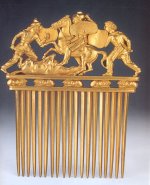uniface
Silver Member
Mentioning Ignatius Donnelly's name triggers the Defenders of Settled Science Orthodoxy and elicits a flood of invictive -- the substance of which boils down to "He's a stinky old poopy head." Never, ever, do the Brain Police recommend reading what he wrote to get a true appreciation of how "crazy" his writings are.
Let's have some fun :
https://malagabay.wordpress.com/2016/02/25/ignatius-donnelly-trans-atlantic-architecture/
Even more fun :
https://malagabay.wordpress.com/2016/02/22/ignatius-donnelly-trans-atlantic-languages/
Let's have some fun :
The mounds of Europe and Asia were made in the same way and for the same purposes as those of America.
Herodotus describes the burial of a Scythian king; he says, “After this they set to work to raise a vast mound above the grave, all of them vying with each other, and seeking to make it as tall as possible.”
“It must be confessed,” says Foster (“Prehistoric Races,” p. 193), “that these Scythic burial rites have a strong resemblance to those of the Mound Builders.”
The pyramids of Egypt, Assyria, and Phoenicia had their duplicates in Mexico and Central America. The grave-cists made of stone of the American mounds are exactly like the stone chests, or kistvaen for the dead, found in the British mounds. (Foster’s ” Prehistoric Races,” p. 109.)
Tumuli have been found in Yorkshire enclosing wooden coffins, precisely as in the mounds of the Mississippi Valley. (Ibid., p. 185.) . . .
https://malagabay.wordpress.com/2016/02/25/ignatius-donnelly-trans-atlantic-architecture/
Even more fun :
https://malagabay.wordpress.com/2016/02/22/ignatius-donnelly-trans-atlantic-languages/
Amazon Forum Fav 👍
Last edited:
Upvote
0




